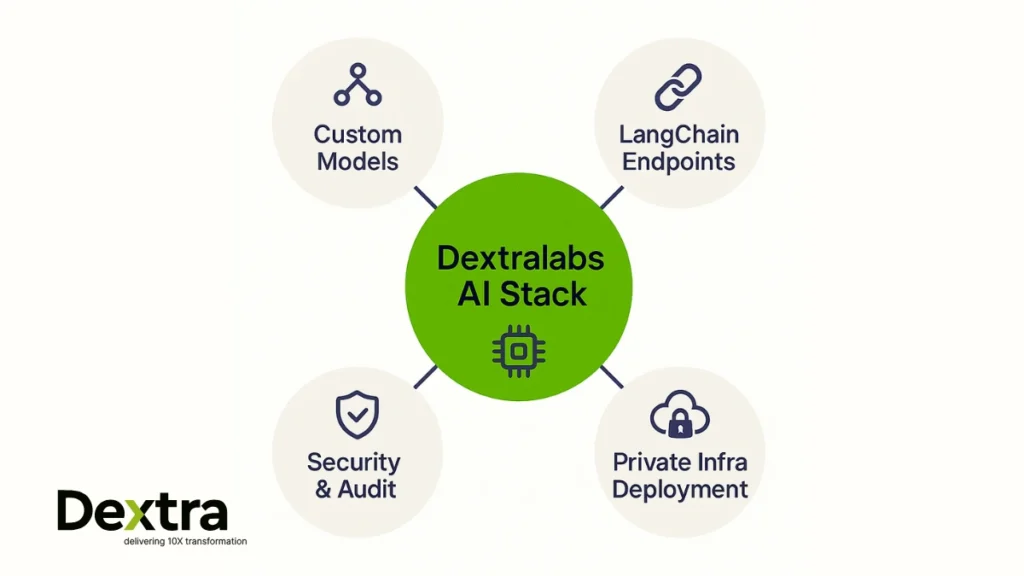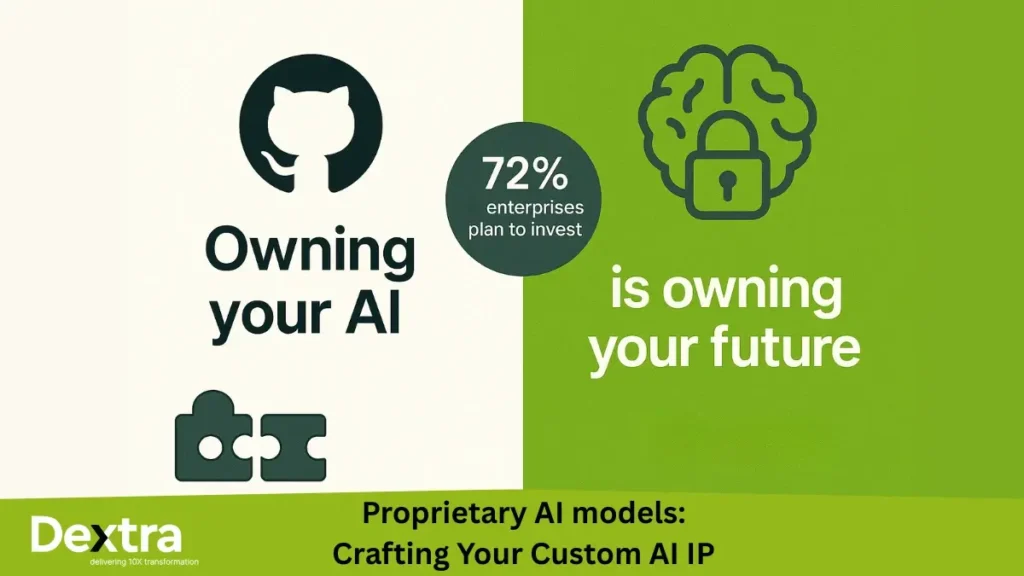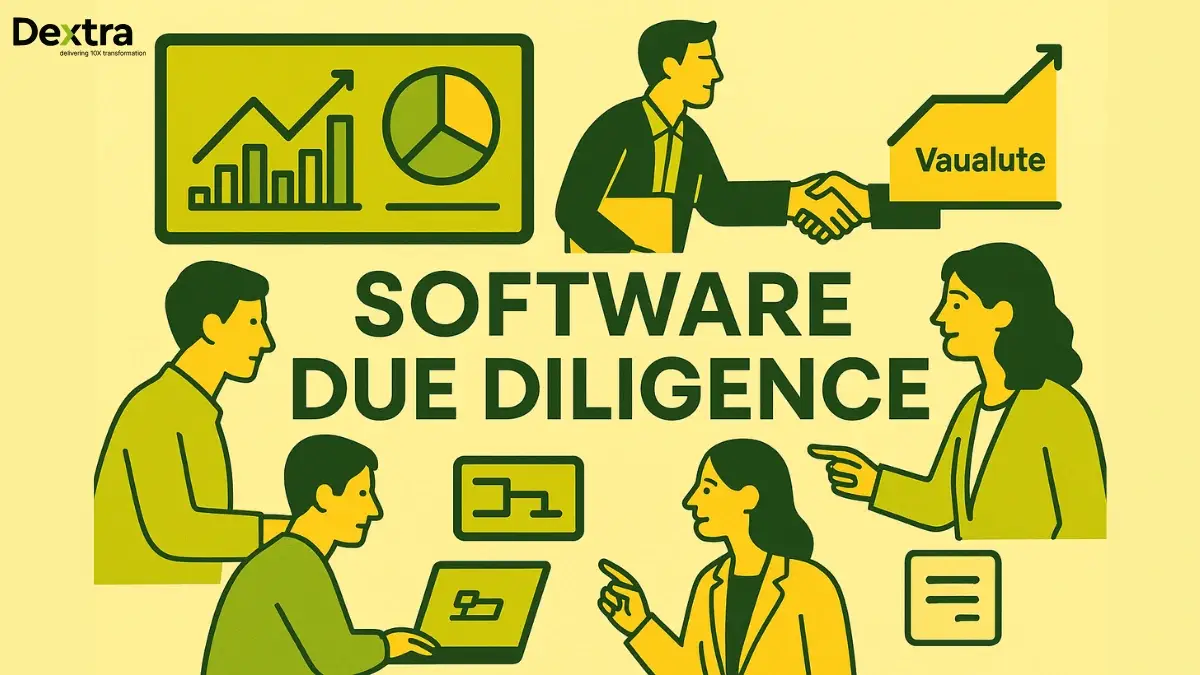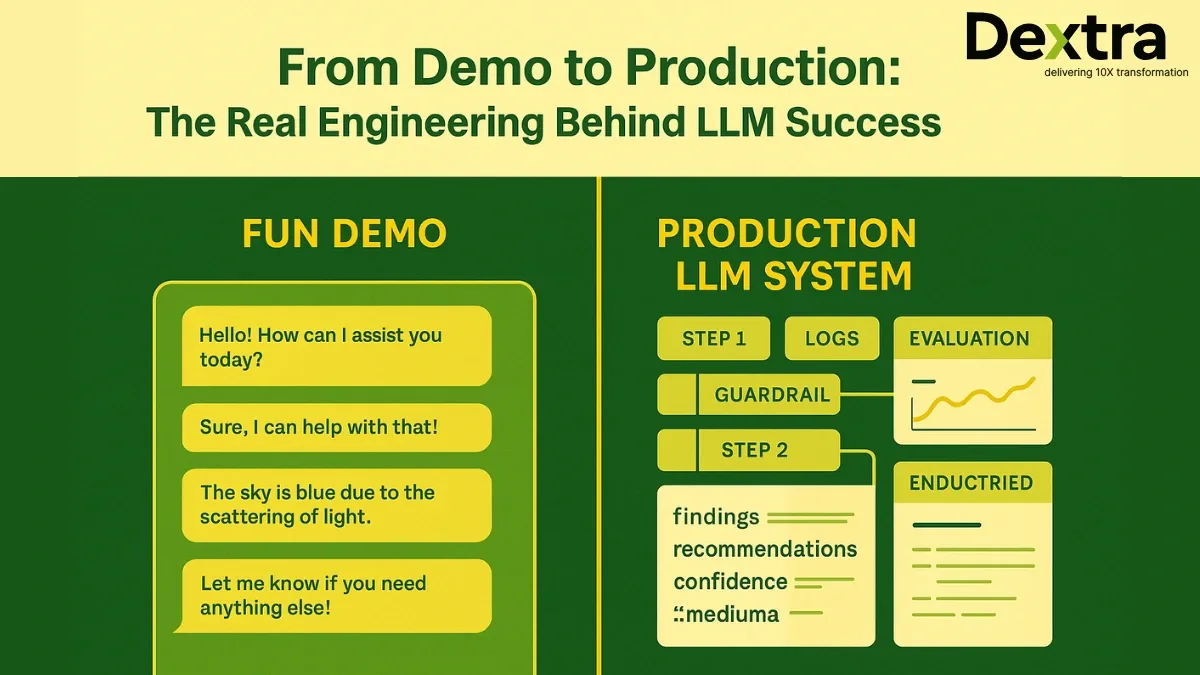Most businesses face an important question: should you use someone else’s intelligence or own your own?
Basing it on open-source or third-party models such as GPT-4 or Claude alone can lead to long-term bottlenecks, restricted customization, undefined data rights, and reliance on other people’s roadmaps. For regulated industry or proprietary data companies, this isn’t just costly; it’s dangerous.
- Actually, 62% of AI initiatives are failing because of ambiguous IP strategy or missing ownership planning (Forrester, 2023).
- And 72% of businesses indicate that proprietary AI models are at the core of their 5-year strategy (Gartner, 2024).
That’s where Dextralabs enters the picture, enabling companies to build and deploy proprietary AI models that are scalable, secure, and their own to own. From data strategy through private deployment, Dextra Labs enables organizations to turn AI from a rented solution into a guarded competitive resource.
In this blog, we explore how proprietary AI works, why it matters, and how your business can take the first step toward building AI you truly control.
What Are Proprietary AI Models?
A proprietary AI model is a privately owned, closed-source artificial intelligence system designed for sole use. Unlike open-source models that are accessible to the public, proprietary AI is developed and maintained by a single entity, giving them full control over its architecture, data, behavior, and usage rights.
In simple terms: If open-source AI is shared infrastructure, proprietary AI is private property.
These models are typically protected under intellectual property laws, with access limited through APIs, licensing, or internal deployment only.
Core Characteristics of Proprietary AI Models
| Feature | Description |
| Closed-Source Code | Source code is not publicly available; no external modifications are allowed. |
| Exclusive Rights | The owner has full control over training data, model behavior, and output. |
| API-Based Access | Access to the model is often limited via subscription APIs. |
| IP Protection | Models are often patented or protected under software IP law. |
| Private Hosting Options | Can be deployed on secure cloud or on-premise environments. |
| Limited Transferability | Licensing terms often prohibit redistribution or resale. |
This makes proprietary models ideal for enterprises seeking data confidentiality, predictable performance, and strategic IP ownership.
Real-World Examples of Proprietary AI Models:
- GPT-4 (OpenAI)
Accessed only through OpenAI’s API or Azure’s hosted environment. Trained on proprietary data and optimized for commercial applications. - Gemini (Google DeepMind)
Integrated throughout Google’s platform (Workspace, Search, Android), Gemini is not open-source and is tuned specifically for Google’s infrastructure. - Claude (Anthropic)
Famous for prioritizing safety and alignment, Claude is only available through Anthropic’s API with no publicly released model weights.
These examples illustrate how firms are making AI strategic assets rather than mere tools.
Want to learn more? Read our analysis of the meaning of proprietary AI models.
Why Build a Proprietary AI Model?
In the age of AI-driven transformation, owning your model means owning your edge. Off-the-shelf models are convenient, but they can result in sacrificing flexibility, control, and long-term sustainability. Having a proprietary AI model helps organizations have complete alignment of their AI systems with business strategy without compromise.
1. Strategic Ownership of IP & Data
Proprietary AI models provide full control over not just the model architecture but also the training data, prompts, and outputs. This transforms your AI from a leased service into a protected intellectual property asset.
“Proprietary models ensure that your AI strategy is not dependent on third-party roadmaps.”
When your data and model logic remain in-house, you gain strategic independence, free from API pricing changes, usage limits, or vendor shutdown risks.
2. Customization for Specific Use-Cases
No two businesses operate the same. Proprietary models allow domain-specific tuning, whether it’s summarizing contracts, detecting fraud, or providing multilingual customer support. You’re not limited to the general-purpose capabilities of open models.
Examples include:
- A retail chain training an AI on customer purchase histories for hyper-personalized recommendations.
- A legal SaaS using custom summarization logic tailored to region-specific clauses.
3. Competitive Advantage Through Differentiation
Proprietary models introduce distinct capabilities that others can’t reverse-engineer. Whether it’s quicker performance, more personalized experiences, or more precise predictions, your model is an extension of your brand and moat.
AI is no longer just a backend engine. It’s part of the product experience, and differentiation here pays off.
4. Data Security & Compliance in Regulated Industries
For industries such as finance, healthcare, and government, public API usage brings with it serious privacy and compliance concerns around data. Proprietary AI enables businesses to:
- Host models on private clouds or on-prem infrastructure
- Implement custom access controls and encryption
- Ensure GDPR, HIPAA, SOC 2 and local regulatory compliance
It’s not just about capability; it’s about control and responsibility.
Custom AI Development Process
Creating a proprietary AI model isn’t just about training a neural network; it’s a structured, strategic process that makes sure your model delivers real value while aligning with business goals, compliance requirements, and long-term IP ownership.
Below is a breakdown of the end-to-end development lifecycle used by AI-forward organizations:

1. Data Strategy & Collection
The foundation of any successful proprietary model lies in curating the right dataset. This involves:
- Identifying high-quality internal data sources (CRM, product logs, support tickets)
- Annotating, cleaning, and formatting data for AI readiness
- Addressing data ownership and usage rights early in the process
Dextralabs works with organizations to create secure, structured pipelines that ensure data sovereignty from day one.
2. Model Prototyping
The next step is to develop a working MVP that helps validate your model’s core functionality.
Typical prototyping includes:
- Using open-source models like Mistral or LLaMA as base
- Rapid iteration with LangChain for prompt chaining
- Building use-case flows (e.g., contract summarization or chatbot triage)
This agile prototyping approach allows quick feedback and iterative improvements before heavy investments are made.
3. Model Training & Fine-Tuning
Once the prototype proves viability, the real training begins.
Key steps include:
- Tokenization using tools like HuggingFace or SentencePiece
- Applying LoRA, QLoRA, or full fine-tuning on domain-specific datasets
- Evaluating using metrics like ROUGE, BLEU, perplexity, and F1 score
Organizations may choose to start with a base model and customize it using internal data, ensuring that performance aligns with real-world tasks.
4. IP & Compliance Audit
Before going live, businesses must ensure that their proprietary AI:
- Respects licensing laws and usage rights of all components
- Meets regional compliance standards (e.g., GDPR, HIPAA, DPDP)
- Has a clear chain of data ownership and retraining audit logs
This phase secures the intellectual property status of the model and prepares the business for safe commercial rollout.
5. Production Deployment
Finally, the model is deployed in a production-grade environment optimized for performance, availability, and security.
Deployment strategies include:
- Hosting on private infrastructure (on-prem or VPC)
- Wrapping models in scalable APIs using LangChain or FastAPI
- Setting up monitoring with tools like LangSmith or Prometheus
The result is a robust, secure, and scalable proprietary model that can serve enterprise-grade workloads in real time.
Dextralabs’ approach focuses on modularity, compliance, and measurable outcomes, guiding teams through each stage with the tools and frameworks needed to reduce risk and accelerate time to value.
Proprietary AI vs Open-Source Models
When developing AI solutions, one of the earliest choices businesses must make is whether to use proprietary or open-source models. Both directions have benefits and tradeoffs. Knowing the main differences assists in directing your AI stack toward long-term objectives.
The following is a feature-by-feature comparison to inform your decision:
Comparison Table: Proprietary vs Open-Source AI
| Feature | Proprietary AI | Open-Source AI |
| Ownership | Full control over model, data, and IP | Shared or none; governed by open licenses |
| Cost | Higher upfront investment for development | Lower barrier to entry, minimal setup cost |
| Customization | Moderate; depends on vendor or in-house team | High; full flexibility to modify and fine-tune |
| Transparency | Low; internal architecture and data often hidden | High; source code and training processes are public |
| Support | Dedicated vendor or in-house support | Community-based forums and contributors |
| Vendor Lock-in | High; tied to the provider’s tools or platforms | Low; easy to switch or fork as needed |
Intellectual Property Considerations
Proprietary AI is not merely the creation of a model; it’s owning a defendable, legally shielded technology asset. With AI at the center of product strategy, handling your model as intellectual property (IP) is the key to long-term control, distinction, and commercial sustainability.
The following are the essential legal and strategic considerations in safeguarding your proprietary AI.
How Proprietary AI Becomes Protected IP?
A proprietary AI model becomes IP when:
- It is developed in-house or under exclusive license
- The training data, model architecture, or outputs demonstrate originality or innovation
- Its usage, distribution, and integration are restricted through licensing
This protection allows businesses to monetize AI through APIs, SaaS platforms, or enterprise tools while preventing unauthorized replication or use.
Patentability of AI Models
Not all AI models are patentable but certain aspects can be, depending on the jurisdiction and use case. Patent protection may apply to:
- Unique model architectures or inference methods
- Novel applications of AI in specific industries
- Innovative training workflows or pipelines
In the U.S., the USPTO will grant patents on AI systems when they show technical novelty and utility. In most instances, however, the emphasis turns away from protecting the model itself and instead towards safeguarding how it is applied.
Licensing and Legal Frameworks
Protecting your proprietary AI also requires strong legal governance through:
- Software licenses that specify under what terms your model can be accessed or integrated.
- End-user license agreements (EULAs) for API or product distribution.
- Client contract confidentiality and use clauses.
Licensing defines the boundaries of commercial use and helps enforce exclusivity in partnerships, especially for API-based deployments.
The Role of Data Ownership in IP Claims
AI models are only as proprietary as the data they’re trained on.
If your dataset includes:
- Customer interactions
- Internal documentation
- Domain-specific knowledge bases
…then you must ensure you have clear ownership and legal rights over that data. Data provenance is critical without it, IP claims can be challenged or invalidated.
Best practice: Keep open documentation of dataset origins, labelling steps, and consent where appropriate.
Solid IP strategy is what transforms your AI into a business asset, not just an operating tool, in the open term. Merging legal, technical, and data governance into your AI development process early on is necessary to make your innovation future-proof.
Examples of Proprietary AI in Action
Proprietary AI models are no longer confined to research labs; they’re powering some of the most widely used platforms and services today. The following examples showcase how leading companies have built, protected, and commercialized their AI through strategic ownership and control.
Case 1: GPT-4 – OpenAI
GPT-4 is one of the most advanced large language models available, but it’s not open-source. OpenAI retains full control over:
- The model’s architecture and training data
- Access via gated APIs through OpenAI and Microsoft Azure
- Fine-tuning and usage restrictions under commercial licensing
By making the model proprietary, OpenAI commercializes GPT-4 via API subscriptions, platform partnerships (e.g., with Microsoft Copilot), and sole-source enterprise access.
Case 2: Gemini – Google DeepMind
Gemini (formerly Bard) is Google’s next-gen LLM series designed for real-world applications in search, productivity tools, and cloud services. Google leverages Gemini by:
- Embedding it across Gmail, Docs, and Android
- Hosting it on their own infrastructure to protect IP
- Offering selective integration through Google Cloud AI tools
By doing so, Google maintains full control of the model lifecycle and uses Gemini to drive both user engagement and enterprise SaaS revenue.
Case 3: Perplexity AI
Perplexity is a fast-growing AI search startup using a proprietary Retrieval-Augmented Generation (RAG) model built on top of open foundations. They differentiate by:
- Owning the unique dataset structure, retrieval logic, and UX layer
- Hosting the model privately to retain control over IP and user behavior
- Monetizing through premium subscriptions and usage-based APIs
Their proprietary stack enables speed, accuracy, and a uniquely grounded experience something generic APIs can’t easily replicate.
How Companies Turn Proprietary AI into Revenue?
Owning the AI stack gives companies flexibility to monetize in ways that suit their business model, including
- SaaS platforms powered by AI (e.g., contract review, summarization, personalization)
- Usage-based APIs for developers and partners
- Enterprise licensing with tailored deployments
- Embedded AI in existing tools to enhance product stickiness
By protecting their models as intellectual property, these companies not only reduce dependency on external tools they build long-term, scalable revenue streams around differentiated AI.
How Dextralabs Helps Build Proprietary AI?

Dextralabs empowers enterprises to build, deploy, and own proprietary AI models with end-to-end support:
- Custom Model Implementation: From base model selection to fine-tuning on your data
- LangChain-Based Endpoints: Modular pipelines for chaining, RAG, and multi-agent flows
- Private Deployment: Host securely on your cloud or on-prem infrastructure
- Security & Compliance: IP audit trails, data privacy controls, and regulatory alignment
Ready to take ownership of your AI stack?
Book a consultation with our team today.
Challenges and Tradeoffs
While proprietary AI unlocks control and long-term value, it also comes with real-world challenges that organizations must prepare for. Understanding these tradeoffs early helps teams build smarter, more sustainable AI strategies.
1. Cost of Development and Maintenance
Building a proprietary model requires significant upfront investment in:
- Data curation
- Model training
- Infrastructure setup
- Ongoing monitoring and updates
Organizations must also account for long-term maintenance costs, including retraining and performance optimization.
2. Vendor Lock-In and Upgrade Paths
When proprietary models are tightly coupled with a single platform or cloud vendor, it can lead to:
- High switching costs
- Limited tooling compatibility
- Dependency on a specific ecosystem
Teams should architect for portability and plan for future migrations where needed.
3. Risk of Model Drift and Performance Decay
Over time, even high-performing models can become less accurate due to:
- Changing data patterns
- New user behaviors
- Outdated training sets
Without regular feedback loops and retraining, performance can degrade in production environments.
Hybrid Models as a Mitigation Strategy
One effective approach is to use hybrid AI stacks:
- Start with a high-quality open-source model (like LLaMA or Mistral)
- Fine-tune it with proprietary data
- Wrap it with private endpoints, access control, and observability
This reduces costs, avoids full vendor lock-in, and allows faster iteration while still giving your business IP control and strategic independence.
Proprietary AI is powerful, but to succeed, it must be built with long-term flexibility and operational resilience in mind.
Conclusion
As AI becomes the backbone of enterprise operations today, owning your AI intellectual property is no longer a choice; it’s a strategic necessity. Proprietary AI models provide you with the ability to define performance, secure data, and create differentiated capabilities that can’t easily be replicated.
By investing in custom AI development, your organization isn’t just following technology; you’re creating a long-term competitive asset that grows with your business.
Control your data.
Protect your IP.
Future-proof your AI stack
Looking to build your proprietary AI model?
Partner with Dextralabs to take it from idea to IP with full support from strategy to deployment.
Book your consultation today








